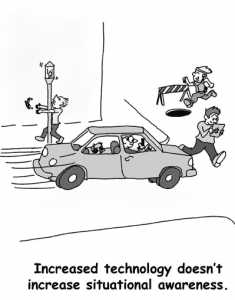 You don’t have to look far and wide to locate clever marketing campaigns that make outrageous claims to improve our lives or solve our problems. I’ve been noticing this trend now as it relates to products claiming they “create” situational awareness.
You don’t have to look far and wide to locate clever marketing campaigns that make outrageous claims to improve our lives or solve our problems. I’ve been noticing this trend now as it relates to products claiming they “create” situational awareness.
I was recently at a conference and had an opportunity to have a discussion with one such “vendor of situational awareness.” I’m sure he wishes he’d never met me.
Here’s what happened…
Outrageous claim
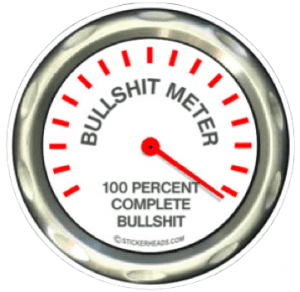 The vendor had his table set up, proudly displaying a large LCD television screen visually presenting a beautiful map. There was no one at his table so I took advantage, inquiring about what he was vending. “Our product creates situational awareness for first responders by…” came the reply. “Really?” I replied. Then I played dumb and asked: “What is situational awareness?” He didn’t answer the question. Instead he jumped immediately into a demonstration of the capabilities of his software (which he, personally, had invented). He showed me its mapping capabilities. He showed me how it displayed building footprints. He showed me pre-plan information. He showed me its incident management capabilities. This went on for almost 40 minutes. All the while I listened attentively while fully aware he had not answered my question.
The vendor had his table set up, proudly displaying a large LCD television screen visually presenting a beautiful map. There was no one at his table so I took advantage, inquiring about what he was vending. “Our product creates situational awareness for first responders by…” came the reply. “Really?” I replied. Then I played dumb and asked: “What is situational awareness?” He didn’t answer the question. Instead he jumped immediately into a demonstration of the capabilities of his software (which he, personally, had invented). He showed me its mapping capabilities. He showed me how it displayed building footprints. He showed me pre-plan information. He showed me its incident management capabilities. This went on for almost 40 minutes. All the while I listened attentively while fully aware he had not answered my question.
When he was done with his spiel he asked if I have any questions. “Yes. I’d like my original question answered. What is situational awareness?” His reply was: “Well, as I’ve been telling you, our software can…” I interrupted him this time as I couldn’t take hearing the spiel again. “If you’re going to claim your product creates situational awareness, shouldn’t you, at the very least, know what it is?” He looked stunned. I walked away so I didn’t create a scene.
I get alerts on my phone anytime an article appears on the internet containing the words “situational awareness.” It may seem nerdy but it’s in my DNA to learn everything I can about SA. From those alerts I’m seeing this claim (Product X creates situational awareness) over and over again. Most of these products are not intended for public safety providers. Rather, they are being promoted to create situational awareness for aviation, military, medical, personal safety, gun safety and maritime applications. The claims are all very similar. “Our product creates situational awareness…” Like hell it does!
The Reality
 These products cannot create situational awareness and such claims should be grounds for legal recourse for false advertising. Such a claim is as ridiculous as a treadmill manufacturer stating “Our treadmills create healthy lifestyles.” No they don’t.
These products cannot create situational awareness and such claims should be grounds for legal recourse for false advertising. Such a claim is as ridiculous as a treadmill manufacturer stating “Our treadmills create healthy lifestyles.” No they don’t.
They provide a tool where the purchaser of the treadmill can, if they so choose, make using the treadmill a component of their healthy lifestyle. The treadmill is just a tool. The user creates their own fitness, in their own bodies.
All these technology tools coming down the pipeline for the fire service or for any group or team yearning to learn about situational awareness is simply that, a tool. Nothing out there now, or forever more, will be able to “create” situational awareness. Situational awareness is developed in the mind, not in the technology.
Helpful or Harmful
 Is the technology helpful or harmful to the end user when it comes to developing situational awareness (noted I did not say “create”)? The answer may not appeal much to those software geniuses who are out there developing sell-able products to unsuspecting end users (i.e., us). The answer is, the technology can be both – helpful and harmful. The benefit, or detriment, of the technology lays in the context in which it is used and the familiarity of the technology to the end user.
Is the technology helpful or harmful to the end user when it comes to developing situational awareness (noted I did not say “create”)? The answer may not appeal much to those software geniuses who are out there developing sell-able products to unsuspecting end users (i.e., us). The answer is, the technology can be both – helpful and harmful. The benefit, or detriment, of the technology lays in the context in which it is used and the familiarity of the technology to the end user.
Ease of Use
 One of my greatest fears (based on the research that has been done in other domains where technological advances have created consequences) is users of the technology will go “head’s-down” on their displays – immersing themselves in the process of navigating the software and reading information on the screen. All the while, other clues and cues, many being much more critical to immediate survival of responders, are being missed. Quite frankly, this scares the hell of me.
One of my greatest fears (based on the research that has been done in other domains where technological advances have created consequences) is users of the technology will go “head’s-down” on their displays – immersing themselves in the process of navigating the software and reading information on the screen. All the while, other clues and cues, many being much more critical to immediate survival of responders, are being missed. Quite frankly, this scares the hell of me.
I recently visited a fire department that uses mobile data computers in their command vehicles. I asked the battalion chief I was talking with to demonstrate how he uses the technology at incident scenes. He fiddled and fumbled with the software, demonstrating to me a lack of intimacy with it. It was slow and cumbersome. He voiced his frustration to me. I only imagined that on emergency scenes he’d either go heads-down on his display or he’d close the lid and command the incident without the benefit of this amazing software that was sold as “creating” situational awareness. I hope, for the sake of his responders, it’s the latter.
Quantity of Information
 One of the big challenges with technology is the shear volume of information it makes available to the end-user. Unfortunately, under stress, volumes of information are not the friend of someone trying to develop and maintain situational awareness. Yes, it seems to run counter-intuitive to think that more information would erode situational awareness, but it can. What a responder needs is not MORE information, but a way to quickly filter information to ensure a small amount of the most IMPORTANT information is at the decision maker’s fingertips. It is very easy for a decision maker to become overwhelmed with information. This can freeze-up the decision making process.
One of the big challenges with technology is the shear volume of information it makes available to the end-user. Unfortunately, under stress, volumes of information are not the friend of someone trying to develop and maintain situational awareness. Yes, it seems to run counter-intuitive to think that more information would erode situational awareness, but it can. What a responder needs is not MORE information, but a way to quickly filter information to ensure a small amount of the most IMPORTANT information is at the decision maker’s fingertips. It is very easy for a decision maker to become overwhelmed with information. This can freeze-up the decision making process.
This was demonstrated nicely in a study conducted on retail decision making. The researchers put eight products on display with signage offering extensive details about each product. Then they observed the buying behaviors of the consumers. Afterwards, they put three products on display and signage offering only a few details about each product. Then they observed the buying behaviors of those consumers. In the first scenario, the more time the consumers spent trying to compare and digest volumes of information about the products, the more likely they were to walk away and make no purchase at all. For the consumers in the second scenario, they spent far less time evaluating the options and were much quicker at making a purchase decision – and they bought far more than the first test group. Volumes of information chokes the decision making process.
Quality of information
 The quality of information is also important. When a decision maker is under pressure, they can only process a small amount of information. If the quality of information is high, the decision is likely to be improved. If the quality of information is low, the decision is likely to suffer. If the decision maker is suspect of the quality (or reliability of the information), it can erode confidence and impact the decision making process as well.
The quality of information is also important. When a decision maker is under pressure, they can only process a small amount of information. If the quality of information is high, the decision is likely to be improved. If the quality of information is low, the decision is likely to suffer. If the decision maker is suspect of the quality (or reliability of the information), it can erode confidence and impact the decision making process as well.
Complexity of Information
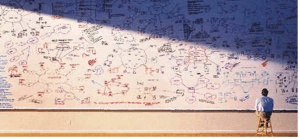 The complexity of the information is also a factor in decision making and situational awareness. The more complex the information, the more brain power it takes to figure things out. As the brain is busy trying to unpack and comprehend complex information, it can miss other critical clues and cues. Some software programs, designed to “create” situational awareness do nothing but overload, overwhelm, confuse, frustrate and distract decision makers.
The complexity of the information is also a factor in decision making and situational awareness. The more complex the information, the more brain power it takes to figure things out. As the brain is busy trying to unpack and comprehend complex information, it can miss other critical clues and cues. Some software programs, designed to “create” situational awareness do nothing but overload, overwhelm, confuse, frustrate and distract decision makers.
Ironically, overload, overwhelm, confusion, frustration and distraction are five barriers to situational awareness I discuss extensively during my Fifty Ways to Kill a First Responder program.
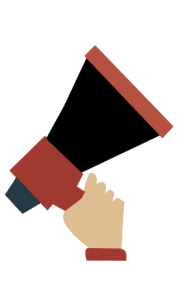
Dr. Gasaway’s Advice
- If you’re going to use technology in emergency situations, understand it will NOT create situational awareness. It will simply improve your access to information, some of which may not be helpful to you and may serve to harm your situational awareness.
- Consider having someone else (e.g., an aide) monitor your technology. The aide could then filter the information and pass along the most critical information essential to good decision making.
- If you’re going to use technology, it is critical for the user to be intimately familiar with how to navigate the technology to expedite how to access the most critical data with the least effort.
- Identify, in advance, what information will be most helpful for various types of emergencies and ensure you know how to access only what you need and nothing more. It is so easy to get distracted with all the information at your disposal. You know this if you’ve ever spent any time on the internet. Too much information can serve as a distraction to situational awareness.
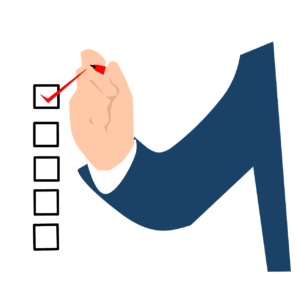 Action Items
Action Items
- Discuss the advantages for using technology as a tool for aiding decision makers.
- Discuss the disadvantages for using technology as a tool for aiding decision makers and discuss how to overcome the disadvantages.
- Discuss what information would be most important in the development of your situational awareness and how technology might be helpful (or harmful).
- If your department uses technology to aid decision makers, discuss real life examples of how the technology has aided or hindered situational awareness.
_____________________________________________________

If you are interested in taking your understanding of situational awareness and high-risk decision making to a higher level, check out the Situational Awareness Matters Online Academy.
CLICK HERE for details, enrollment options and pricing.
__________________________________
Share your comments on this article in the “Leave a Reply” box below. If you want to send me incident pictures, videos or have an idea you’d like me to research and write about, contact me. I really enjoy getting feedback and supportive messages from fellow first responders. It gives me the energy to work harder for you.
Thanks,

Email: Support@RichGasaway.com
Phone: 612-548-4424
SAMatters Online Academy
Facebook Fan Page: www.facebook.com/SAMatters
Twitter: @SAMatters
LinkedIn: Rich Gasaway
Instagram: sa_matters
YouTube: SAMattersTV
iTunes: SAMatters Radio
iHeart Radio: SAMatters Radio

Great article Chief!
One of the many lessons I learned (the hard way); develop curriculum “teaching points” first, then use the minimum amount of technology to deliver it. It is all about using a tool to empower the Instructor and Student.
There was a time when I would develop simulations/scenarios with lots of eye candy, and cool features, just because I could. It bogged me down by extending development time, and added no meaningful substance to the class I was teaching.
Technology is great, but as you said, “It is a tool”.
Keep up the good work, because situational awareness DOES MATTER!
Jim,
Thank you for sharing your experience. That adds value for the readers of SAMatters and I appreciate your contributions. We can all be hopeful that with age has come wisdom.
Best of the holidays to you!
Rich
That is a genius thing they did with less products and less detailed information on the signage.
That makes so much sense but how many of us follow it?
We try to bombard people with information and hope that something sticks and they buy from us.
This article is right, we are over complicating the process!
Excellent read,
I just passed this on to a colleague who was doing a little research on that.
And he actually bought me lunch as I found it for him.
So let me rephrase that: Thank you for lunch!
Excellent article, Rich.
I agree with what you wrote, but I really enjoyed you sharing your frustration with us … it’s a bonding thing, lol.
The “situational awareness” you showed by walking away from the vendor, rather than educating him may have come from your prime decision making bank, or your BS meter (nice touch) that the information you would have given him, could have been used as a tool to sell his wares.
Keep up the good work brother.
Thanks brother.
It’s been frustrating at the vendor shows for sure. They’re all trying to sell the solution to situational awareness shortcomings when they don’t even know what the hell the problem is. In some instances their “solutions” are CREATING problems.
Keep sharing the message.
Rich
Using Technology can be indeed heaven or hell. The main problems are identification and feature creep. As a firefighter (volunteer) and software engineer, I have been on both sides.
A real developer has the ability to create great innovative software solution (hardware engineers great hardware). Thanks to the world they live in, features are a high prio. You (the users) measure great software by its features (can it do x, and y, etc) This is called feature creep. This creates a narrowed vision for developers. When the tools are deployed they are over complex for the task needed. So it is more Microsoft, less apple;) This usually is a lack of identification with the (so called ) user base. When you look at a fire quad , they have limited time to get information. They have to value the information, create a plan and delegate for execution.
Getting to much tasks, would severely interrupt the actions leading to stabilization and clear commands, leading to potential problems. Engineers would know this if they can imagine they are on the hot seat. Project manager usually do not give the possibility. Early design usually is made at middle or higher management ( who sometimes don’t know the inside of the engine)
In the Netherlands we have on average 4 (four) – 7 (seven) minutes between riding from the station to the incident. During these minutes, software should facilitate the engine. Depending on the fase, it should give the info…pushed not pull. The commander cannot do everything and do it right…
For instance: show route, dispatch knows car information, pushes available images, it shows extraction guide Show route, dispatch pushes the building plans, indication of hydrant
So in the above case, the system filters the information and prevents an information overload. It makes dispatch more important! (Trained to filter data)
I think the best is yet to come… (hope all the English statements are ok)
Patrick,
Thank you for sharing an international perspective. This is valuable to the SAMatters community. Our problems are really universal and we benefit so much from the interaction.
Rich
Pingback: Situational Awareness Survey | Situational Awareness Matters!™Situational Awareness Matters!™
Nice article, We are in the technology era and it continuously keeps on evolving. The application packages we use are always being upgraded with an intent of betterment.
great job done by you.
Keep it up with good work
Nice article! Thanks for sharing informative post Keep posting
Thanks for sharing such a master piece.
Using Technology can be indeed heaven or hell. The main problems are identification and feature creep. As a firefighter (volunteer) and software engineer, I have been on both sides.
Technology’s impact on situational awareness is a fascinating dichotomy. On one hand, it equips us with instant data and tools to better understand our surroundings, but on the other, an overreliance on it can blind us to critical details. Striking a balance between leveraging tech for heightened awareness while staying attuned to the present challenges us to navigate this delicate intersection effectively.
Wonderful post! Your clear and concise writing style makes complex topics easily understandable. Looking forward to more of your work!
Hi, I read your blog very carefully. you write Technology Can Help AND Hurt Situational Awareness. I also recommend including that topic technology can significantly enhance situational awareness by providing real-time data, improving communication, and enabling better decision-making through advanced tools like GPS, drones, and augmented reality. These tools are praised for increasing safety and efficiency in various environments, from military operations to everyday navigation. thanks
Gary
Awesome article! The points you made are spot on and very informative. I appreciate the effort you put into this. Well done!
Thank you for sharing such valuable information through this post. I truly appreciate your insights. Please continue to provide updates and more articles. For those interested, you can learn more about Askeva and its updates here.
This article offers a compelling perspective on the complexities of technology in situational awareness. The author rightly points out that while technology can provide valuable tools, it cannot create situational awareness—this is something that is developed in the mind. The potential for information overload and the reliance on complex software can detract from critical decision-making processes, especially in high-stress environments.
I appreciate the emphasis on the importance of being familiar with the technology and using it as an aid, rather than a crutch. The advice to focus on the quality of information and to have an aide monitor the technology to filter critical information is practical and essential for maintaining effective situational awareness. This article is a must-read for anyone involved in emergency response or any field where quick, informed decisions are crucial.
What an excellent article! The tips you provided are really helpful. I’ll definitely be using these in the future.
“I’ve learned a lot from reading your article. Thank you for your excellent work on this topic.”
I read your article about modern technology in WordPress. It is very informative I like reading your article.
Great insights! I completely agree that technology can be both a blessing and a curse when it comes to situational awareness. While it provides valuable information, it can also overwhelm and distract if not used properly. The point about being familiar with the technology and filtering only the most critical information is crucial, especially in high-pressure situations. This article really emphasises the importance of balancing technology with human judgement. Thank you for sharing these valuable tips!
Thank you for putting this together—it was truly helpful.
Appreciate the effort behind this write-up. It’s as engaging as discovering new shows on tv.youtube.com/start. Keep up the good work!
Another interesting perspective on how technology influences modern business practices can be found here: Cursed Memes: A New Take on Technology. It highlights some unconventional ways technology is shaping the digital landscape, worth checking out for a fresh perspective!
Another interesting perspective on how technology influences modern business practices can be found here: Cursed Memes: A New Take on Technology. It highlights some unconventional ways technology is shaping the digital landscape, worth checking out for a fresh perspective!
Hi SaMatters Team,
This is an insightful article on the impact of technology on situational awareness. It’s fascinating how technology can both enhance and hinder our ability to stay aware of our surroundings. The balance between leveraging technology for safety and preventing it from becoming a distraction is something that I believe everyone should be more mindful of.
At EdgyTips, we often explore how technology influences various aspects of daily life, and this piece really highlights the complexities of its role in safety and awareness. The section on how technology can cause over-reliance, leading to potential risks, really stood out to me—it’s a point that deserves more attention.
Thank you for such an eye-opening read! It’s a reminder that while technology has incredible benefits, we must remain vigilant in how we use it.”
“Great read on how Celsius is using AI to revolutionize the beverage industry! It’s impressive how they integrate AI into product development, customer engagement, and supply chain management. The use of predictive analytics for demand forecasting and marketing is truly innovative. I’m looking forward to seeing how AI continues to shape the future of this market. For more insights, check out this detailed article: Does Celsius Use AI Technology?”
Your blog has been such a blessing—thank you for sharing your knowledge with us. Speaking of appreciation, Culver’s is looking for customer feedback at tellculvers.com/survey. It’s nice to see businesses care!
THIS IS A VERY GOOD WEBSITE